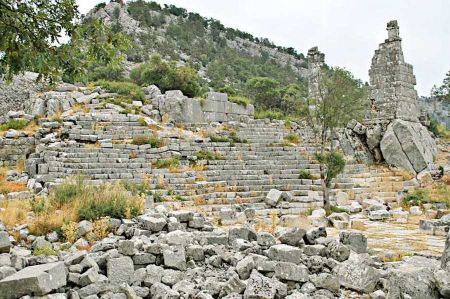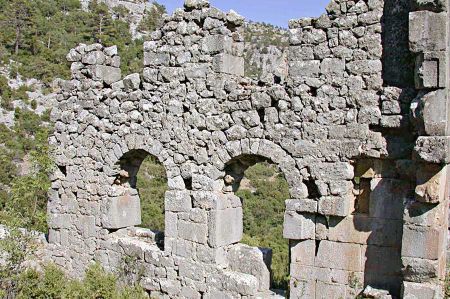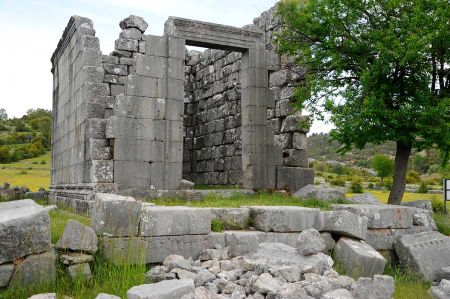Adada - basilicas and imperial temples in the forgotten city
- Written by Portal Editor
Adada was an ancient Roman city in Pisidia, about 40 km southeast of Egirdir and 80 km northeast of Antalya, near the present-day village of Sagrak in the Sütçuler district of the Turkish province of Isparta, which is probably just known to hikers on St. Paul's Way.
We drive over secondary roads to the village of Yeniköy, the route of which leads through the ruins of Adada. The fields of ruins can be seen from afar on both sides of the road. Take good shoes with you so that you can roam the grounds. Sometimes there is a guard on site who will be happy to help you locate the individual positions of the monuments for a small fee.
Imperial temple and coinage
 The ancient city lies in a relatively flat, wide high valley. The four imperial temples of the 2nd / 3rd centuries are still well preserved. Easily you will find the agora with a large staircase and the theater. One of the temples is documented with inscriptions for the emperors and Zeus Sarapis, the second with inscriptions for the emperors and Aphrodite, the third only for the emperors, and the fourth with coins for Trajan. Furthermore, you will find two late antique three-aisled basilicas. Adada was first visited by the scientist A. Schönborn in 1842, then rediscovered in 1884 by the American J. R. S. Sterrett. Gustav Hirschfeld and William M. Ramsay identified the city again in 1887.
The ancient city lies in a relatively flat, wide high valley. The four imperial temples of the 2nd / 3rd centuries are still well preserved. Easily you will find the agora with a large staircase and the theater. One of the temples is documented with inscriptions for the emperors and Zeus Sarapis, the second with inscriptions for the emperors and Aphrodite, the third only for the emperors, and the fourth with coins for Trajan. Furthermore, you will find two late antique three-aisled basilicas. Adada was first visited by the scientist A. Schönborn in 1842, then rediscovered in 1884 by the American J. R. S. Sterrett. Gustav Hirschfeld and William M. Ramsay identified the city again in 1887. Adada is mentioned for the first time in an inscription from the 2nd century BC. Just little is known about the history of the Roman imperial era, but the four emperor temples mentioned before have been well known for Adada. The first coins have been produced since the 1st century BC. Known too that the imperial coinage ranges from Trajan to Valerian. In late antiquity, Adada was also a bishopric.
Adada is mentioned for the first time in an inscription from the 2nd century BC. Just little is known about the history of the Roman imperial era, but the four emperor temples mentioned before have been well known for Adada. The first coins have been produced since the 1st century BC. Known too that the imperial coinage ranges from Trajan to Valerian. In late antiquity, Adada was also a bishopric.
Adada – The Forgotten Roman City in the Mountains of Pisidia
Introduction – Where the Past Meets Silence
 Have you ever heard of Adada? Most people haven't – and that's precisely what makes this place so special. Deep in the rugged mountains of Pisidia, in the heart of what is now the Turkish province of Antalya, lies an almost forgotten city: Adada, once a thriving centre of Roman civilization. Without crowds of tourists, without stalls, but with breathtaking nature, tranquillity, and an atmosphere that invites you to dream.
Have you ever heard of Adada? Most people haven't – and that's precisely what makes this place so special. Deep in the rugged mountains of Pisidia, in the heart of what is now the Turkish province of Antalya, lies an almost forgotten city: Adada, once a thriving centre of Roman civilization. Without crowds of tourists, without stalls, but with breathtaking nature, tranquillity, and an atmosphere that invites you to dream.
Adada: A Hidden Gem of the Turkish Riviera
 The Turkish Riviera is known for its beaches, hotels, and ancient ruins. But Adada is different: secluded, wild, and mysterious. Just a few kilometres from Sütçüler, a narrow road winds into the mountains, past olive trees, cypresses, and gorges – until you suddenly come across Roman temples, stone paths, and an ancient agora. Here, at an altitude of approximately 1,200 meters, time seems to have stood still.
The Turkish Riviera is known for its beaches, hotels, and ancient ruins. But Adada is different: secluded, wild, and mysterious. Just a few kilometres from Sütçüler, a narrow road winds into the mountains, past olive trees, cypresses, and gorges – until you suddenly come across Roman temples, stone paths, and an ancient agora. Here, at an altitude of approximately 1,200 meters, time seems to have stood still.
The History of Adada – From Pisidians to Romans
The origins of Adada date back to the time of the Pisidians, a warlike people who never fully submitted to the Hellenes. Later, during the Roman Empire, the city flourished. It became part of the Roman province of Galatia and was strategically located on the ancient Via Sebaste, a military road connecting the most important cities of Pisidia. Adada was politically, religiously, and economically important – especially due to its proximity to Selge, another center of the region.
Adada as a Religious Centre
 Adada's role as a religious centre is particularly fascinating. Archaeological finds show that several temples dedicated to the gods Zeus Sarapis, Cybele, Artemis, and Trajan stood here. This diversity demonstrates how the Roman pantheon and Anatolian beliefs merged. Pilgrims came here to bring offerings and draw strength from the sacred.
Adada's role as a religious centre is particularly fascinating. Archaeological finds show that several temples dedicated to the gods Zeus Sarapis, Cybele, Artemis, and Trajan stood here. This diversity demonstrates how the Roman pantheon and Anatolian beliefs merged. Pilgrims came here to bring offerings and draw strength from the sacred.
The Most Important Sights of Adada
Those visiting Adada will find no gated areas or ticket booths – and that's precisely what makes it so magical. You'll wander freely among the ruins, walk along ancient cobbled streets once trodden by legionaries, and discover:
1. The Temple District
Here are the best-preserved temples in the entire region. Particularly impressive is the Temple of Zeus, with its still-standing columns and a mighty podium. Right next to it: the temples of Artemis and Trajan. Each temple follows the typical Roman style, with Corinthian capitals and carved friezes.
2. The Ancient Road (Via Sebaste)
 This road, which is still accessible today, was part of the legendary Via Sebaste.
This road, which is still accessible today, was part of the legendary Via Sebaste.
With original cobblestones, it leads through dense forests and rolling hills – a perfect place for hikers and history buffs.
3. The Agora and Administrative Buildings
Remains of a large agora (marketplace), with the foundations of administrative buildings and residential buildings, provide an impression of urban life in Adada.
Tablets, inscriptions, and stone steles have been found here – many of them now in the Antalya Archaeological Museum.
Adada as a Mirror of Roman Urban Planning
Despite its isolation, Adada follows the classic Roman urban layout: a temple in the centre, surrounded by the agora, administrative buildings, and streets. The architecture is simple but well-thought-out. Aqueducts, walls, and street layouts demonstrate the technical expertise of Roman engineers – even storm drains can still be seen.
Why Adada Was Almost Forgotten
 Unlike Ephesus or Side, Adada always remained small – and was almost completely abandoned with the decline of the Roman Empire in the 4th century AD. Its isolation protected the ruins from looting, but also made them invisible for centuries. It wasn't until the 1970s that Turkish archaeologists began the first excavations.
Unlike Ephesus or Side, Adada always remained small – and was almost completely abandoned with the decline of the Roman Empire in the 4th century AD. Its isolation protected the ruins from looting, but also made them invisible for centuries. It wasn't until the 1970s that Turkish archaeologists began the first excavations.
Nature meets history – the unique ecosystem
Adada is located in a natural park surrounded by pine forests, wild herbs, and a rich wildlife. Endemic plant species found nowhere else in the world grow here. Eagles circle over the ruins, goats graze among the remains of temples. The tranquillity, the chirping of cicadas, and the scent of pine and thyme make the visit a sensory experience.
An insider tip for hikers and cultural travellers
The path to Adada is part of several hiking trails, including sections of the St. Paul Trail, one of Turkey's most important long-distance trails. Those who hike here not only experience spectacular nature but also history up close – with no entry fee, no barriers, but a true sense of belonging to the past.
Photography in Adada – a paradise for creatives
 Whether you're an amateur photographer or an influencer, Adada offers unique motifs. The symmetrical temple columns, weathered inscriptions, the play of light and shadow on ancient stone – all framed by wild nature. The light is especially magical at sunrise or late afternoon.
Whether you're an amateur photographer or an influencer, Adada offers unique motifs. The symmetrical temple columns, weathered inscriptions, the play of light and shadow on ancient stone – all framed by wild nature. The light is especially magical at sunrise or late afternoon.
Tips for getting there and visiting
- Getting there: By car from Antalya towards Isparta/Sütçüler, then continue on a narrow mountain road to Adada (approx. 3 hours)
- Equipment: Hiking boots, water, sunscreen, camera
• Best time to visit: Spring (April–June) and fall (September–October)
• Special feature: No infrastructure – no restrooms, no food stalls – bring everything yourself!
• Recommendation: Combine your visit with a detour to Selge or the Köprülü Canyon
Adada as a place of contemplation
 In addition to its archaeological significance, Adada is also a place to pause and reflect. Those who sit on one of the stone benches among the ruins, far from the noise of the world, sense something timeless. Perhaps the echo of a Roman. Perhaps just the wind. But certainly, a deep connection to history and nature.
In addition to its archaeological significance, Adada is also a place to pause and reflect. Those who sit on one of the stone benches among the ruins, far from the noise of the world, sense something timeless. Perhaps the echo of a Roman. Perhaps just the wind. But certainly, a deep connection to history and nature.
Conclusion – Adada is more than just a ruin
Adada is an insider tip for anyone seeking authentic places. Not a backdrop for tourist groups, but a true place of the past – quiet, powerful, untouched. If you want to experience history, you must experience Adada. It is a place that speaks quietly – but has all the more to say.
Frequently Asked Questions (FAQ)
 1. How do I get to Adada?
1. How do I get to Adada?
It is best to go by car from Antalya via Sütçüler. Public transport does not go directly there.
2. Do I have to pay an entrance fee?
No, visiting the ruins is free.
3. Are there guided tours?
Not currently official – but possible with a guide from Antalya or Isparta.
4. Is Adada suitable for children?
Yes, with caution. The paths are uneven, but there is much to discover.
5. Is it worth visiting even in hot weather?
Early morning or late afternoon, yes – it gets very hot in the midday heat in summer!
Please also read:
